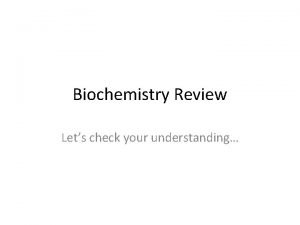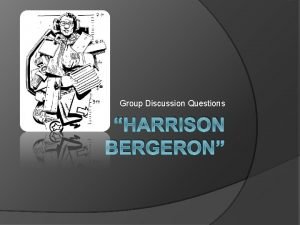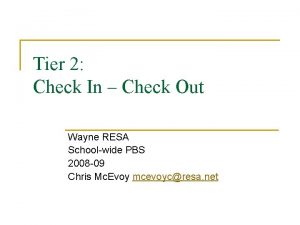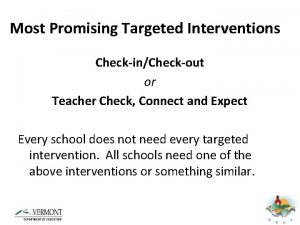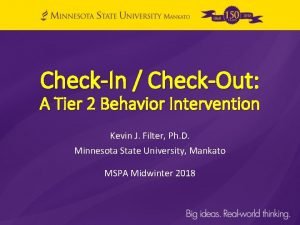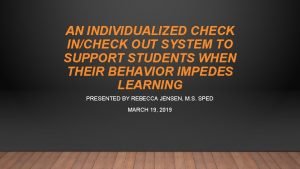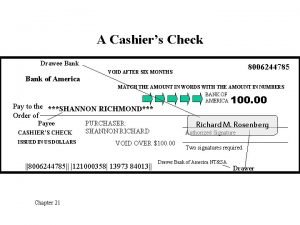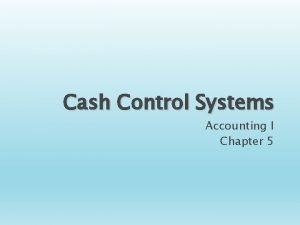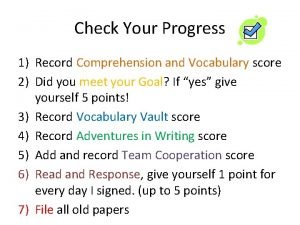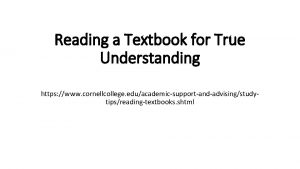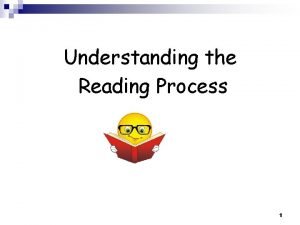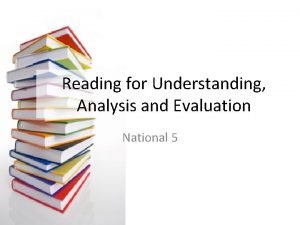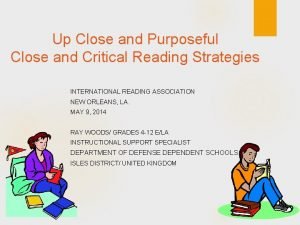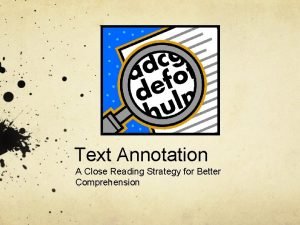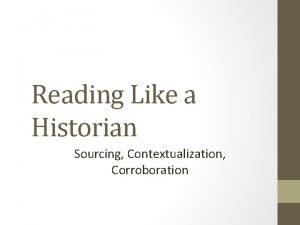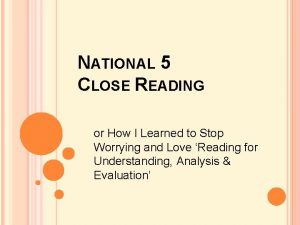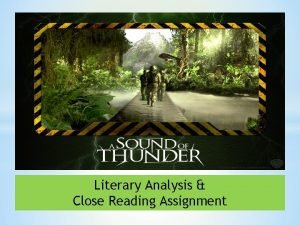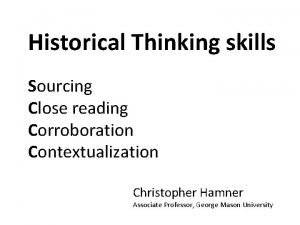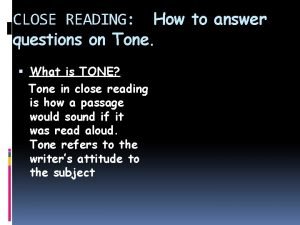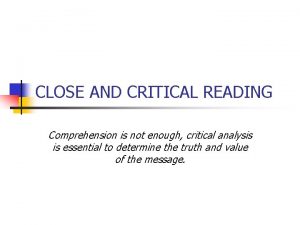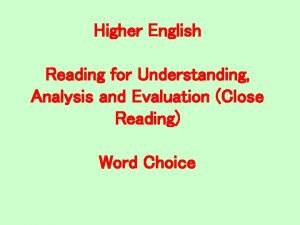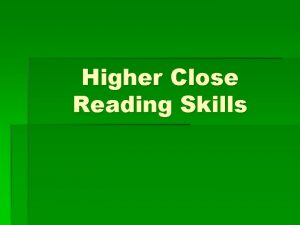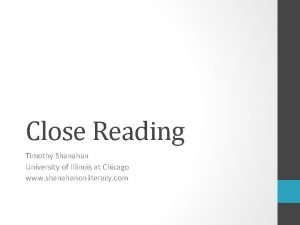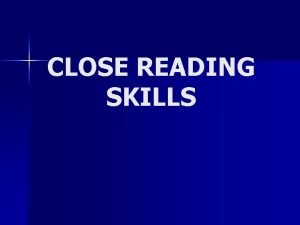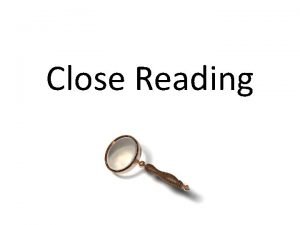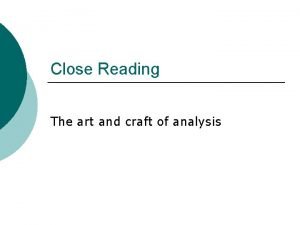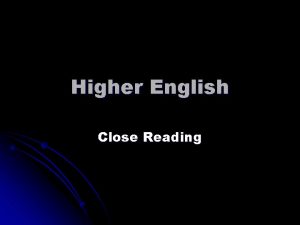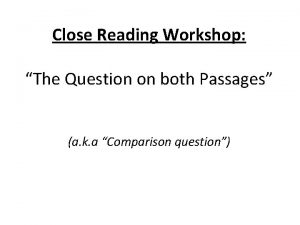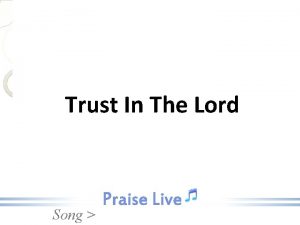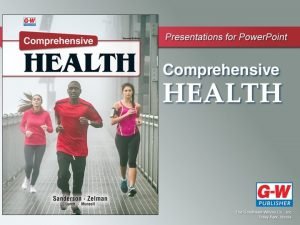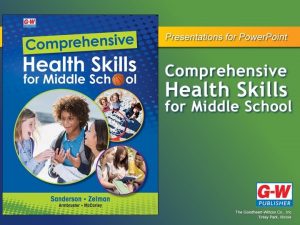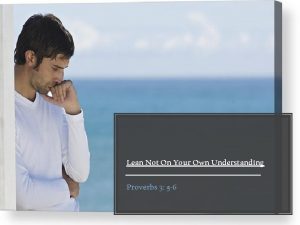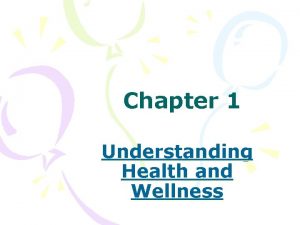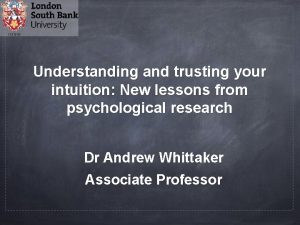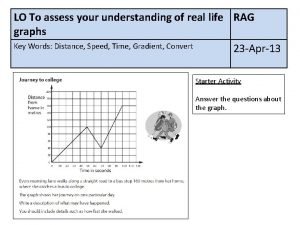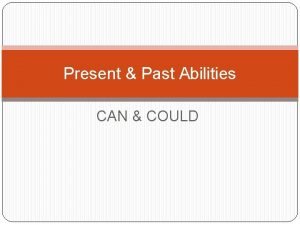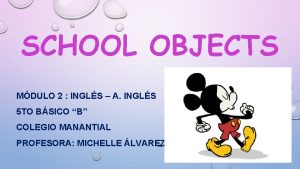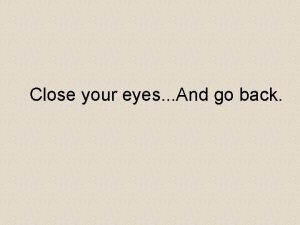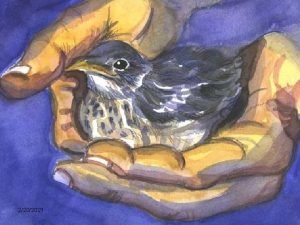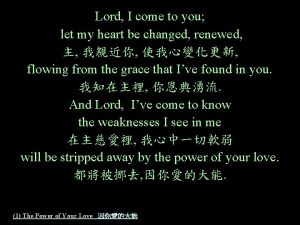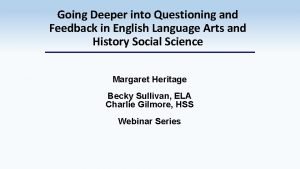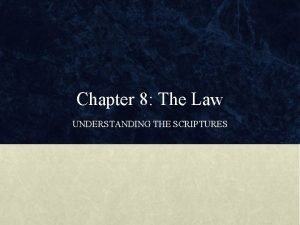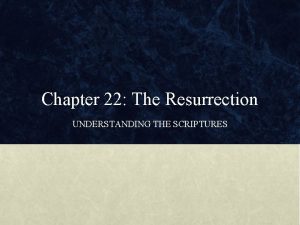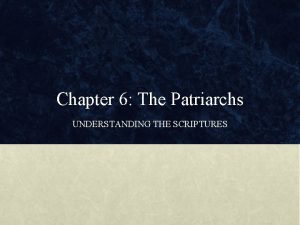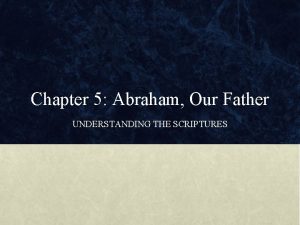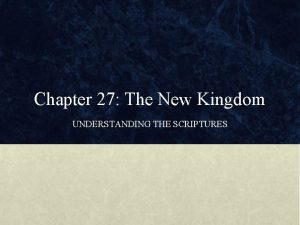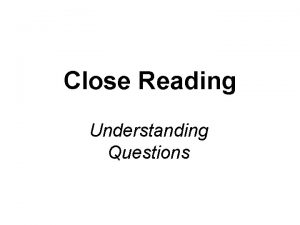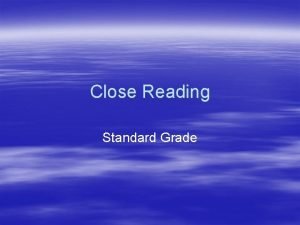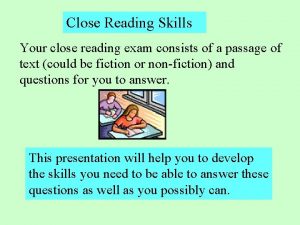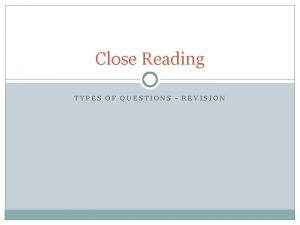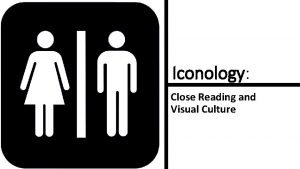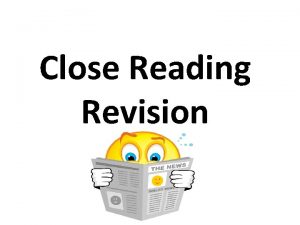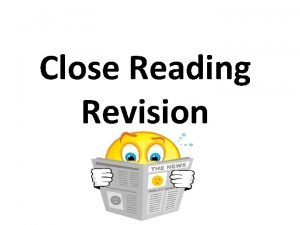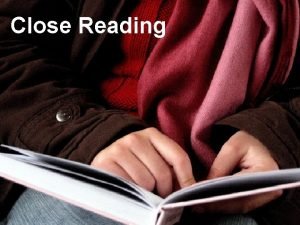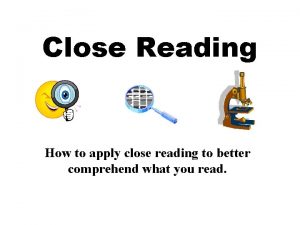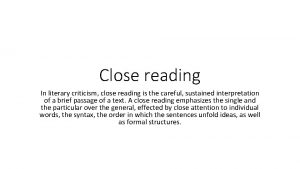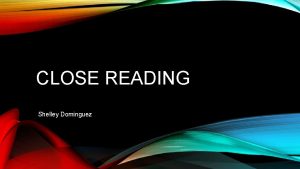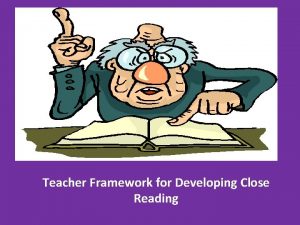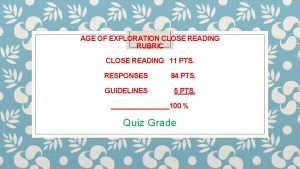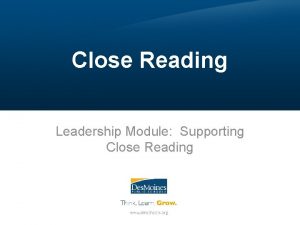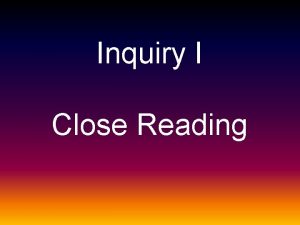Close Reading Close Reading Understanding Questions Check your






































































- Slides: 70

Close Reading

Close Reading �Understanding Questions �Check your understanding (!) of the passage �Come in 2 basic types: �Factual, or “own words” questions (the most common type) �Context questions

Close Reading Factual Questions Two steps to success: 1) Highlight, circle or underline the information that will answer the question 2) “Translate” this information into your own words in such a way that it answers the question you have been asked. Key words from the passage must be changed: you get nothing for “lifting” words from the passage.

Close Reading Example: I’m nocturnal. I love the moonlight, the shadows, the dark places, the dappled murk. I’m not being poetic. I’m simply being true to my nature, my nocturnal nature. Like all tarantulas. Question: In your own words, in what way is the speaker “like all tarantulas”? (1 mark)

Close Reading Example: I’m nocturnal. I love the moonlight, the shadows, the dark places, the dappled murk. I’m not being poetic. I’m simply being true to my nature, my nocturnal nature. Like all tarantulas. Question: In your own words, in what way is the speaker “like all tarantulas”? (1 mark)

Close Reading Example: I’m nocturnal. I love the moonlight, the shadows, the dark places, the dappled murk. I’m not being poetic. I’m simply being true to my nature, my nocturnal nature. Like all tarantulas. Question: In your own words, in what way is the speaker “like all tarantulas”? (1 mark) Answer: The speaker is active by night.

Close Reading �Understanding questions 2: �CONTEXT QUESTIONS �These ask you how the context of a word helps you to understand its meaning. There are two stages to answering these questions: 1. Write down what you think the word means (take an intelligent guess if necessary!) 2. Show the context helps you understand it by quoting words or phrases which give you clues.

Close Reading Example: I’m nocturnal. I love the moonlight, the shadows, the dark places, the dappled murk. I’m not being poetic. I’m simply being true to my nature, my nocturnal nature. Like all tarantulas. Question: Show the context helps you understand the meaning of “nocturnal”.

Close Reading I’m nocturnal. I love the moonlight, the shadows, the dark places, the dappled murk. I’m not being poetic. I’m simply being true to my nature, my nocturnal nature. Like all tarantulas. Suggested Answer: Nocturnal means being active at night. The writer refers to his preference for “moonlight” and “dark” which both suggest night-time.

Link Questions �These questions ask you to show a sentence acts as a link in the writer’s argument or “chain” of thought

Link Questions There are 2 main steps to answering a link question: �First, quote the part of the sentence which refers back to the writer’s previous topic, and explain what this topic is �Second, quote the part of the sentence which refers forwards to the next topic, and explain what this topic is

Link Questions For instance: William Shakespeare is easily the best-known of our English writers. Virtually every man in the street can name some of his plays and his characters, and many people can also recite lines of his poetry by heart. However, despite our familiarity with his work, we know relatively little of the man himself. We do not know when or why he became an actor, we know nothing of his life in London, and almost nothing of his personal concerns. Question: Show the third sentence acts as a link in the argument. 2 marks

Link Questions For instance: William Shakespeare is easily the best-known of our English writers. Virtually every man in the street can name some of his plays and his characters, and many people can also recite lines of his poetry by heart. However, despite our familiarity with his work, we know relatively little of the man himself. We do not know when or why he became an actor, we know nothing of his life in London, and almost nothing of his personal concerns.

Link Questions For instance: William Shakespeare is easily the best-known of our English writers. Virtually every man in the street can name some of his plays and his characters, and many people can also recite lines of his poetry by heart. However, despite our familiarity with his work, we know relatively little of the man himself. We do not know when or why he became an actor, we know nothing of his life in London, and almost nothing of his personal concerns.

Link Questions �Answer: The phrase "our familiarity with his work" looks back at the topic of how widely known Shakespeare's work is. The second part of the sentence, "we know relatively little of the man himself”, introduces the new topic, namely the things that are not known about Shakespeare, and a list of these follows this "link" sentence.

Close reading Question type 2: Analysis ANALYSIS means looking at the writer’s style: �word-choice �imagery �Sentence structure: �Sentence type/length �Use of punctuation �Word order �formal/informal style �tone (or mood)

Close Reading �Analysis questions may: �Ask you about specific techniques, (e. g. comment on the writer’s word choice in lines 14 -15; Comment on the sentence structure in paragraph 3 etc. ), �Or may simply ask you to comment on the techniques used by the writer, in which case it is up to you to identify and comment on the writer’s techniques.

Close Reading Analysis questions 1: Word Choice �Word choice questions ask you to comment on the shades of meaning (connotations) of individual words. �You need to be able to explain why the connotations of a particular word are appropriate, i. e. why has the writer chosen this particular word at this point. �A good way of approaching this is to think of a more “neutral” word the writer could have used, and to think about what difference this would make to their meaning.

Close Reading Task: Write down as many synonyms for these words as you can think of: �Walk �Speak

Close Reading Example Question Mr Smith trudged up the corridor towards his 4 th year class, who were eagerly awaiting their close reading lesson. Question: What does the writer’s word choice tell us about the teacher’s attitude to his class? (2)

Close Reading Example Question Mr Smith trudged up the corridor towards his 4 th year class, who were eagerly awaiting their close reading lesson. Question: What does the writer’s word choice tell us about the teacher’s attitude to his class? (2)

Close Reading Example Question Mr Smith trudged up the corridor towards his 4 th year class, who were eagerly awaiting their close reading lesson. Question: What does the writer’s word choice tell us about the teacher’s attitude to his class? (2) Possible answer: The word “trudged” has connotations of slow, heavy movement, and it shows us that Mr Smith was unhappy or lacking in enthusiasm for his class.

Close Reading Analysis Questions 2: Imagery Mostly concerned with three ‘figures of speech’ �Simile �Metaphor �Personification

Imagery Simile Signified by the use of like or as…as. e. g. �The messenger ran like the wind �The poppies were as red as blood Easy to recognise –trickier to explain

Imagery The messenger ran like the wind �It is not enough to say ‘the messenger ran very fast’ because this just gives you the meaning (denotation) when you will be asked about its effect �A better beginning would be: The simile (quote it) gives the impression of speed because the wind is fast �But this will still not explain why the writer specifically chose ‘wind’ so…

Imagery … an even better answer �The simile (quote it) gives the impression of speed because the wind is seen as a powerful force which reaches great speeds. It might also suggest that the runner was so fast that he was creating turbulence like the wind. �N. B. you need to explain denotation plus connotation

Why is this simile effective? �the poppies were as red as blood �Answer (This simile is effective) because it tries to communicate the intensity of the red colour of the poppies. The word ‘blood’ suggests not just colour, but the richness of the flower’s tone.

Why use a metaphor? �The metaphor is the most powerful form of imagery �Metaphor says one thing is something else �Good metaphors contain a lot of information that can be transferred economically to the reader �Think about the connotations of this metaphor and what it conveys to you about the umbrellas: As the wind strengthened the men clung on to the big, black birds of their umbrellas. Few words but lots of ideas.

So. . . To work with a metaphor you need to: 1. Identify the metaphor – but you get no marks for that on its own. 2. Show the connotations of the metaphor help to develop or refine your idea of what is being described 3. Show the link between the connotations which you have chosen and the literal meanings of the words used in the metaphor (2 and 3 can be reversed)

Example 1 �Too many tourists are so wedded to their camera that they cease to respond directly to the places of beauty they visit. They are content to take home a dozen rolls of exposed film instead, like a bank full of monopoly money. Show the metaphor highlights the writer’s disapproval of the tourists

So how do we apply this formula? 1. 2. 3. The metaphor is ‘wedded’ (0 marks) The connotations of ‘wedded’ are being in a permanent relationship as a result of being married, dependency, closeness, exclusivity All of which have the effect of illustrating how completely indispensable and consuming the camera is to the tourist as if they are married. Answer: The metaphor “wedded” suggests that just as a married couple are in a close, long-lasting relationship in which they depend on each other, so the tourists are completely dependent on their cameras, as though they could not imagine life without them

Personification �Personification is a sub-set of metaphor �Some thing or an animal is given human attributes �Analyse it in the same way as a metaphor �Consider ‘the sky wept’

Imagery - Summary 1. Identify or quote the image (simile, metaphor or personification) 2. Show the literal and figurative (denotation and connotation) come together to create an effect e. g. “Just as … so …” 3. Say what the effect is – why is the writer using it in this way?

ANALYSING IMAGERY �For each example, write down: �Identify the technique/image �Analyse the connotations/meaning of the image �Link the image to the writer’s intended meaning ie. The writer uses this metaphor to show that in the same way that a hurricane is unstoppable and violent, the boxer is described as aggressive and overwhelming.

EXAMPLE 1 I mourn for kids who will never know the delight of cycling with the wind in their hair, or climbing up trees or exploring hidden places. Growing up devoid of freedom, decision-making, and the opportunity to learn from taking their own risks, our children are becoming trapped, neurotic and as generally weakened as battery hens. How effective do you find the image of “battery hens” in conveying the writer’s view of the way children are currently being brought up?

EXAMPLE 1 ANSWER The writer uses this simile to suggest that just as battery hens are reared in a restrictive and controlled environment, considered cruel and unhealthy, so young people are also lacking in freedom to explore and enjoy their surroundings, with similar consequences for their health and happiness.

EXAMPLE 2 She was particularly shocked by one headline A DOOR WE CAN’T CLOSE. She said, “It makes me feel like vermin. ” Show the language of these lines shows how strongly she felt.

EXAMPLE 2 ANSWER She appears to feel very strongly about this headline because the simile of vermin suggests that she feels low, despised by everyone, just as if she was a dirty, disease-carrying rat which people avoid.

EXAMPLE 3 The UK is not a group of nations swamped by a tidal wave of immigration. Relatively speaking, Europe contends with a trickle of refugees compared with countries who border areas of famine, desperate poverty or violent political upheaval. What is the impact of the imagery in these lines in making clear the writer’s point?

EXAMPLE 3 The UK is not a group of nations swamped by a tidal wave of immigration. Relatively speaking, Europe contends with a trickle of refugees compared with countries who border areas of famine, desperate poverty or violent political upheaval. What is the impact of the imagery in these lines in making clear the writer’s point?

EXAMPLE 4 Whether the specific storms that scythed down trees in Paris last Christmas, drowned Po valley last month and battered Britain last week can be attributed to the warming trend is a subject of serious – and contentious – scientific debate. Show the writer uses imagery to emphasise the impact of the storms which affected Europe. You should refer to two examples in your answer.

EXAMPLE 5 And in August this year, a tremor of apprehension ran through the scientific community when the Russian icebreaker Yamal, on a tourist cruise of the Arctic, muscled its way through the unusually thin ice to the North Pole to find itself sailing serenely into an astonishing blue sea. What impression are you given of the progress of the Yamal by the imagery of these lines?

EXAMPLE 6 The rain batters the glass roof of the conservatory, competing with the loud music blaring from the sound system inside. Show the imagery conveys the strength of the rain.

EXAMPLE 7 Comment on each of these images: The shop was a goldmine for its owners. An army of football supporters arrived in town. His remark in class was met with stony silence. The actor gave a very wooden performance.

EXAMPLE 8 (SYMBOLISM) But, the bat broke. Some kid used it without permission. He hit a foul ball and the bat split, the barrel flying away, the splintered handle still in the kid’s hands. When the bat broke, it seemed a certain spell was broken too. I drifted away from baseball by steps and bounds. The next summer, 1967, Ali was convicted of dodging conscription. Baseball did not seem very important. Show the bat is an important symbol for the writer.

Analysis 3 - Sentence Structure �The ‘structure of a sentence’ means the way in which it is made up, and how the various elements are arranged. �To answer questions on sentence structure, you need to: �A) Identify and describe the significant feature(s)of sentence structure �B) Comment on their effect.

Sentence Structure �LITTLE �PEOPLE �WILL �TRIUMPH �… PERHAPS

Sentence Structure � L - Length of sentences � P - Punctuation � W - Word order � T - Type of sentence st nd rd � P - Person (1 , 2 , 3 ) ittle eople ill riumph erhaps

What should I look for?

Step One: �Little - Length of sentences �Consider whether sentences are long and complex or short and simple �Long sentences often use lists to suggest the variety and complexity of their subject matter, and they may build up to a climax (or anti-climax) �Short sentences are more typical of spoken language and can be used to create a sense of shock, pace, tension, or simply to reflect a more colloquial (spoken, informal)tone.

Punctuation P eople - Punctuation �Commas (, ) separate phrases and clauses within a sentence. �A number of commas may well indicate a list. �A colon (: ) introduces a quotation or a list; an explanation or elaboration; or a summing up. �There will often be a balance between the two parts of the sentence it divides. �A semi-colon (; ) finishes off one part of a sentence. It may be used to separate two main clauses in a sentence, or to separate lengthier items in a list

�Inverted commas (‘’)(“”)mark quotations, direct speech, foreign words or words used in an unusual or ironic way. (Italics may sometimes be used similarly. ) �A dash (—) can function like a colon to introduce a quotation, list, explanation, elaboration or summing up; two dashes can mark off a parenthesis. (In typography, a dash is longer than a hyphen. ) �A hyphen (-) joins two words to make a compound word, or indicates a split word at the end of a line.

Parenthesis �A parenthesis is an extra piece of information inserted into a sentence and enclosed by a pair of commas, brackets or dashes. �The plural of this word is parentheses. �A parenthesis may be a single word, a phrase or a whole clause. �While the grammar and basic sense of the sentence would remain intact if the parenthesis were omitted, it will add something significant.

An Example… �Parenthesis may make the meaning clearer, by adding an explanation or clarifying detail: �e. g. , ‘A girl, not of her set, called Judith, giggled. ’ �In this example from The Prime of Miss Jean Brodie, the first parenthesis implies a reason why the girl was cheeky enough to giggle, while the second makes clear which girl it was.

Parenthesis Continued �Alternatively, a parenthesis may affect the tone by adding a comment, which might be humorous or ironic; for example: �‘On the friendly Greek island of Cephalonia, the Elephtherious (try saying that with a mouthful of moussaka) will welcome you with open arms. ’ �‘The responsibility of the officer is to look after, to supervise, to lead (whatever that means). ’

Will - Word order �The best advice is that anything unusual probably deserves a comment. �A reversal of the normal word order is known as inversion, e. g. , ‘back we went’ instead of ‘we went back’. �Using inversion throws emphasis on to a particular part of the sentence — in this example it is the word ‘back’ which is stressed.

Word Order � Often a pattern will be clear to see in a sentence. Three patterns are specially common: � list � repetition � climax � Julius Caesar’s legendary saying ‘I came, I saw, I conquered’ is an example of all three of these techniques at once. � The list of verbs ‘came, saw and conquered’ creates a sense of action. � The repetition of the personal pronoun ‘I’ suggests a speaker who is egotistical and dominating. � The verbs in the list have a sense of progress and end with the most powerful, leading to the effect of a climax.

Triumph - Type of sentence �Look out for the types of sentence the writer uses. �Here are the main types and the effect each type is likely to have:

Statements — tell you something. � They end in a full stop. � Most sentences are statements, so it is usually if other types of sentence are used that you will need to comment. � Writing which is made up of statements alone may have a calm or impersonal tone. Questions — ask something. � They always end with a question mark. � Using questions may challenge the reader, or show uncertainty in the writer. � Look out for rhetorical questions, which do not expect an answer, e. g. , ‘What kind of an answer is that? ’ Such questions aim to stir up strong feelings in the reader, such as anger. � They create what is called an emotive tone, which simply means one which stirs up feelings or emotions. Commands — tell you to do something. � ‘Think of a number’. They end with either a full stop or an exclamation mark. � They are often used in advertisements or where the writer tries to create the effect of talking directly to the reader

�Exclamations — express excitement or surprise. �‘How beautiful it was!’ ‘What a place!’ ‘Goodness gracious!’ �Exclamations do not always contain verbs. They often begin with ‘What’ or ‘How’, like the first two examples, and end in either an exclamation mark or a full stop. �Exclamations may also create an emotive or dramatic tone. �Minor Sentences — don’t contain a verb. Since they are abbreviations of other types of sentence they may end in a full stop or a question mark. �‘What now? ’ ‘Time for a rest’. Such sentences will be very short and may create a tense or dramatic mood. �They are typical of informal language

Perhaps - Person st (1 , nd 2 , rd 3 ) �First person writing (“I”, “Me”, “We” “Us”) may create a sense of personal experience, passion or conviction. First person plural (“we” “us”) may be used to include the reader in the writer’s argument. �Second person (“you”) is often used in persuasive writing to address the reader directly, making them feel more involved , and perhaps challenged, by the argument �Third person (“he”, “she”, “they” etc. ) is more likely to indicate a calmer, more impersonal tone, and is often used in informative writing

ANALYSING SENTENCE STRUCTURE �Identify the sentence structure technique �Comment on the effect/reason for it – explain why the writer has used sentence structure this way.

EXAMPLE 1 The fox scuttled from its fox hole; out over the meadow it sped; the dogs bounded after it, their tongues lolling, their breath trailing along their backs; they were gaining; the fox darted to the left, wheeled away to the right; a scuffle and a short scream; the chase was over. How is sentence structure used in this passage?

EXAMPLE 1 ANSWER The sentence is long to show the length of the chase. The use of semi-colons gives the impression of a rapid sequence of connected actions in the story.

EXAMPLE 3 Eerily, from the mist on the moor, came a low whistle.

EXAMPLE 3 Eerily, from the mist on the moor, came a low whistle. ANSWER: The writer uses inversion to create a sense of mystery and suspense by placing the word “eerily” at the start of the sentence and holding back the subject of the sentence (“whistle”) until the very end.

EXAMPLE 4 We will not be dictated to by government. We will not be satisfied with any compromises. We will not be content until our demands are met.

EXAMPLE 4 We will not dictated to by government. We will not be satisfied with any compromises. We will not be content until our demands are met. ANSWER: Repetition is used to bring out the determination of the speaker as well as emphasise the collective feelings of the protest group.

EXAMPLE 5 The girls were creating havoc in the classroom; the boys were quietly studying in the library.

EXAMPLE 6 Who does not believe that education must have priority? Who does not believe that our schools and colleges have been underfunded? Who does not believe that the time has come to invest in the future? And that future is our children.
 Let's check your understanding
Let's check your understanding Who is the antagonist in harrison bergeron
Who is the antagonist in harrison bergeron How do you link back to the question
How do you link back to the question Behavior check in check out sheet
Behavior check in check out sheet Behavior check in check out sheet
Behavior check in check out sheet Check in check out
Check in check out Check in check out system for students
Check in check out system for students Jobbank
Jobbank Polygonal check and raster scan check are types of
Polygonal check and raster scan check are types of Check in checkout
Check in checkout Check-in/check-out intervention template
Check-in/check-out intervention template The fan blade is speeding up. what are the signs of
The fan blade is speeding up. what are the signs of Restrictive check endorsement
Restrictive check endorsement Check your progress 1
Check your progress 1 While reading activities
While reading activities Give us your hungry your tired your poor
Give us your hungry your tired your poor Work in pairs. discuss the questions below
Work in pairs. discuss the questions below Reading a textbook for true understanding
Reading a textbook for true understanding Language experience approach example
Language experience approach example Reading for understanding analysis and evaluation
Reading for understanding analysis and evaluation Close and critical reading
Close and critical reading Close reading symbols
Close reading symbols Sourcing corroboration contextualization
Sourcing corroboration contextualization Signposts in reading
Signposts in reading National 5 close reading
National 5 close reading Close reading assignment
Close reading assignment Sourcing contextualization corroboration close reading
Sourcing contextualization corroboration close reading Wat is close reading
Wat is close reading Close reading definition
Close reading definition Questions about tone
Questions about tone Close reading definition
Close reading definition Close and critical reading
Close and critical reading Close reading a poem
Close reading a poem Notice and note close reading
Notice and note close reading How to answer word choice questions higher english
How to answer word choice questions higher english Higher close reading
Higher close reading Timothy shanahan close reading
Timothy shanahan close reading One piece intro english
One piece intro english Close reading protocols
Close reading protocols Close reading the art and craft of analysis
Close reading the art and craft of analysis Higher english close reading
Higher english close reading Dentify a key term used in both passages.
Dentify a key term used in both passages. Understanding your stakeholders
Understanding your stakeholders Lean not on your own understanding song
Lean not on your own understanding song The ability to locate interpret and apply information
The ability to locate interpret and apply information Understanding your health and wellness
Understanding your health and wellness Understanding your health and wellness
Understanding your health and wellness Lean not on your own understanding
Lean not on your own understanding Chapter 1 understanding your health and wellness
Chapter 1 understanding your health and wellness Understanding your business finances
Understanding your business finances Understanding your digital footprint
Understanding your digital footprint Chapter 1 lesson 1 your total health
Chapter 1 lesson 1 your total health Miymaths
Miymaths Understanding your intuition
Understanding your intuition Distance time graph activity
Distance time graph activity Close your eyes
Close your eyes Imagine present continuous
Imagine present continuous Close your eyes imagine that you are the protagonist
Close your eyes imagine that you are the protagonist Close your copybook
Close your copybook Close your eyes and go back
Close your eyes and go back Rise up like an eagle
Rise up like an eagle Hold me close let your love surround me
Hold me close let your love surround me Analyzing questions examples
Analyzing questions examples Enduring understanding example
Enduring understanding example Understanding the scriptures chapter 24 study questions
Understanding the scriptures chapter 24 study questions Understanding the scriptures chapter 22 study questions
Understanding the scriptures chapter 22 study questions Understanding the scriptures chapter 20 study questions
Understanding the scriptures chapter 20 study questions Essential questions: opening doors to student understanding
Essential questions: opening doors to student understanding Understanding the scriptures chapter 6 study questions
Understanding the scriptures chapter 6 study questions Understanding the scriptures chapter 5 study questions
Understanding the scriptures chapter 5 study questions Understanding the scriptures chapter 4 study questions
Understanding the scriptures chapter 4 study questions
